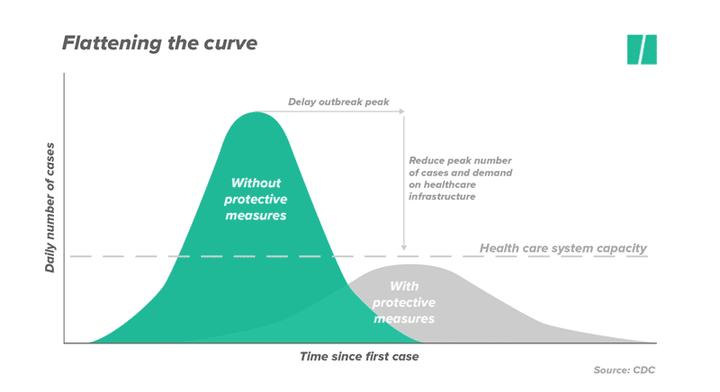The global coronavirus pandemic has spawned plenty of advice from experts — get tested, stay home if you’re sick and for goodness’ sake, wash your hands!
Many strategies to combat the pandemic in Canada are being implemented by the federal and provincial governments, from isolating travel to hard-hit countries to limiting large gatherings of people. As Canada’s number of confirmed cases passed 100 and the number of cases worldwide topped 100,000 this week, many people are wondering what they can do to keep themselves and those around them safe and healthy.
One expression you’ve likely seen circulating is this idea of “flattening the curve.”
But what does that mean? And why should you know about it?
What is the curve?
The “curve” in this case is an epidemic curve — a tool used by scientists and health officials to track the number of cases reported each day during an epidemic. The one going viral - no pun intended - right now was created by the U.S. Centers for Disease Control and popularized by The Economist. It argues that with proper intervention, the impact of an epidemic, like the current COVID-19 one, can be lessened.
The curve starts out small, before reaching a peak number of cases and eventually levelling off as the threat of the epidemic dissipates. The bottom axis denotes time, while the vertical denotes the number of cases.
The size of the sections of the curve — often referred to as the three phases — are all influenced by different things, including how the disease is transmitted, when symptoms show up and what resources a society has to contain the outbreak.
Why do we need to “flatten” it?
The image has gone viral, alongside the hashtag #FlattenTheCurve.
At a certain point along the vertical axis of the curve is the capacity of a country’s health-care system. So the number of patients who can be supported by a country’s beds or ventilators or doctors. If the curve goes above this line, health care systems start to collapse and things get worse. But if it doesn’t, the outbreak remains manageable.
The height of the curve depends on how early we intervene.
“If we can achieve that, it’ll mean we’ll be able to treat everyone who needs treating,” microbiologist Siouxsie Wiles wrote in The Spinoff.
Italian doctor Daniele Macchini outlined the realities of reaching peak health-care capacity in a viral Facebook post earlier this week.
“Every ventilator becomes like gold: those in operating theaters that have now suspended their non-urgent activity become intensive care places that did not exist before,” he wrote of the crisis in Italy, where over 1,000 people have died from COVID-19. “And there are no more surgeons, urologists, orthopedists; we are only doctors who suddenly become part of a single team to face this tsunami that has overwhelmed us.”

By flattening the curve, a country can lessen the burden on its health-care system and spread cases out over time.
Federal Health Minister Patty Hajdu addressed the concept Wednesday, noting that it informed how the Canadian government was moving forward.
“The intent of flattening the curve is to ensure that everyone doesn’t get sick at once,” she said. “We all have a role to play in reducing the curve; the curve, the extreme peak of illness all at once, is what puts your health system in crisis.”
So how do we flatten the curve?
The best way to flatten the curve is to follow the advice of public health officials — namely, wash your hands, avoid crowds and practise social distancing.
Celebrities and doctors alike are taking to social media with the hashtag #FlattenTheCurve to raise awareness of these tactics.
Large scale operational decisions and government policies can greatly contribute to flattening the curve, especially in the early stages of an outbreak. Strategies like suspending the seasons of sports leagues like the NBA, NHL and MLB are a way of stopping large gatherings of people where the virus can spread. Closing schools — like the Ontario government just announced they will — can also help.
But individuals can also do their part. Social distancing — staying away from vulnerable people and isolating yourself if you start to get sick — can help dramatically. As can washing your hands and not touching your face.
Also on HuffPost: